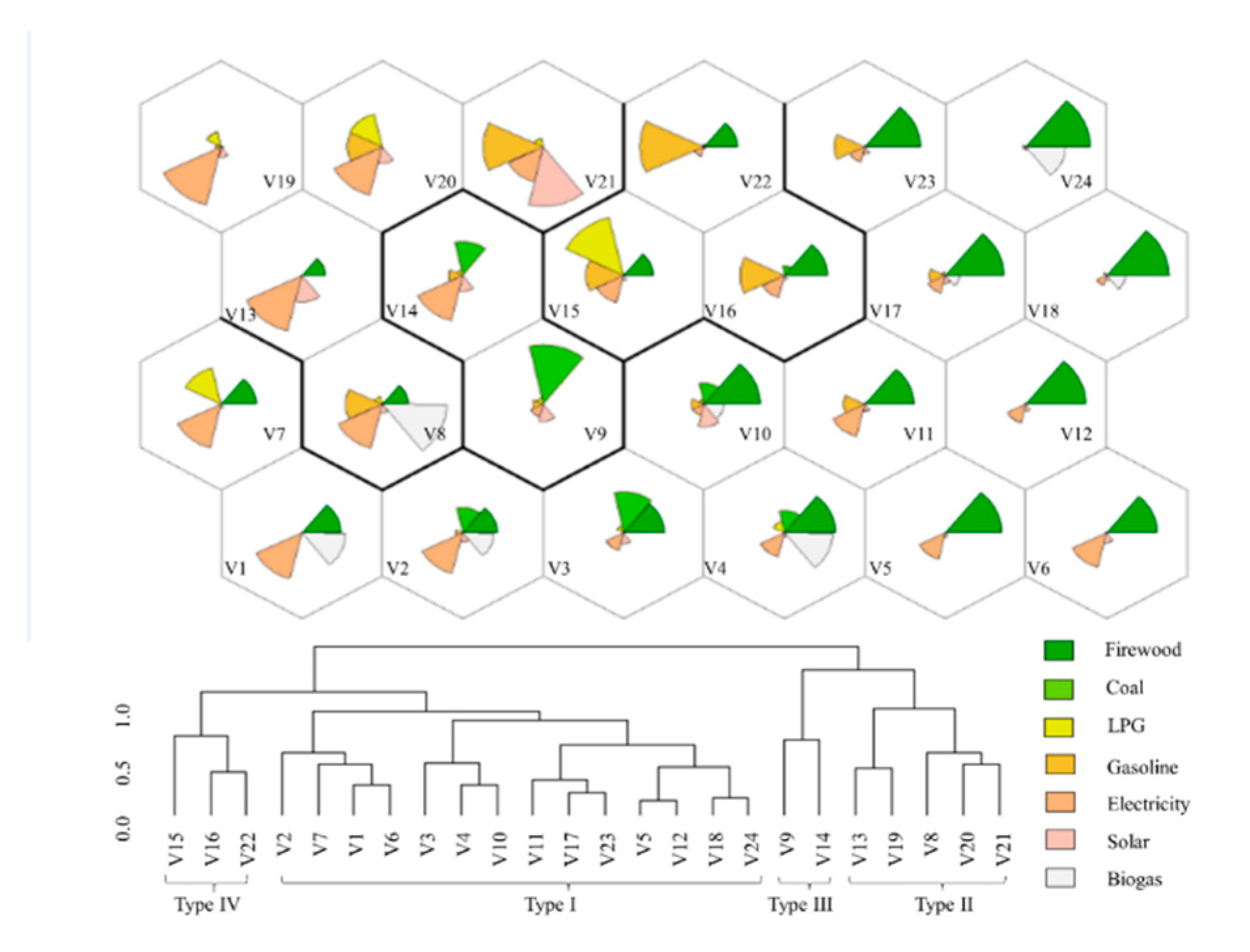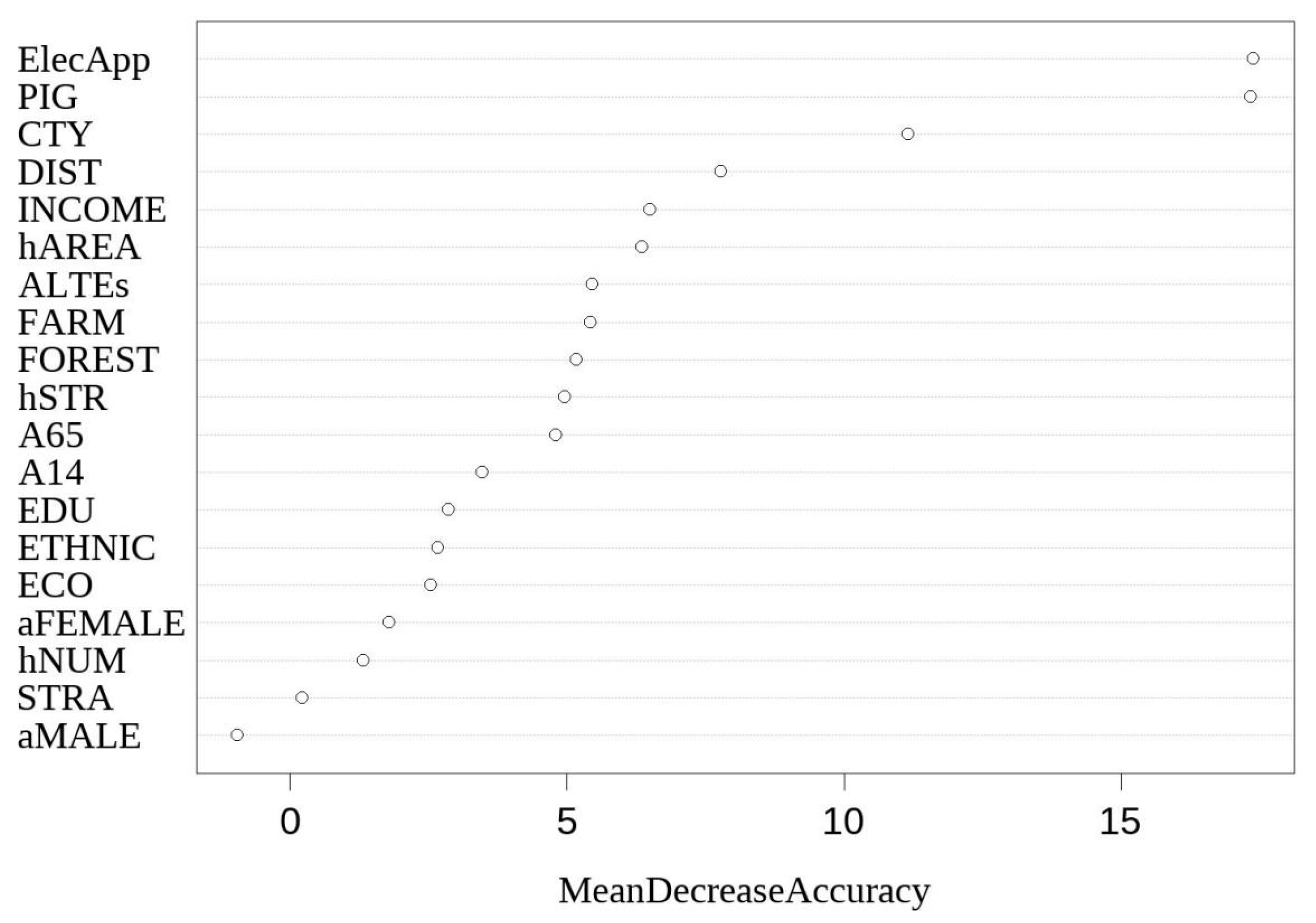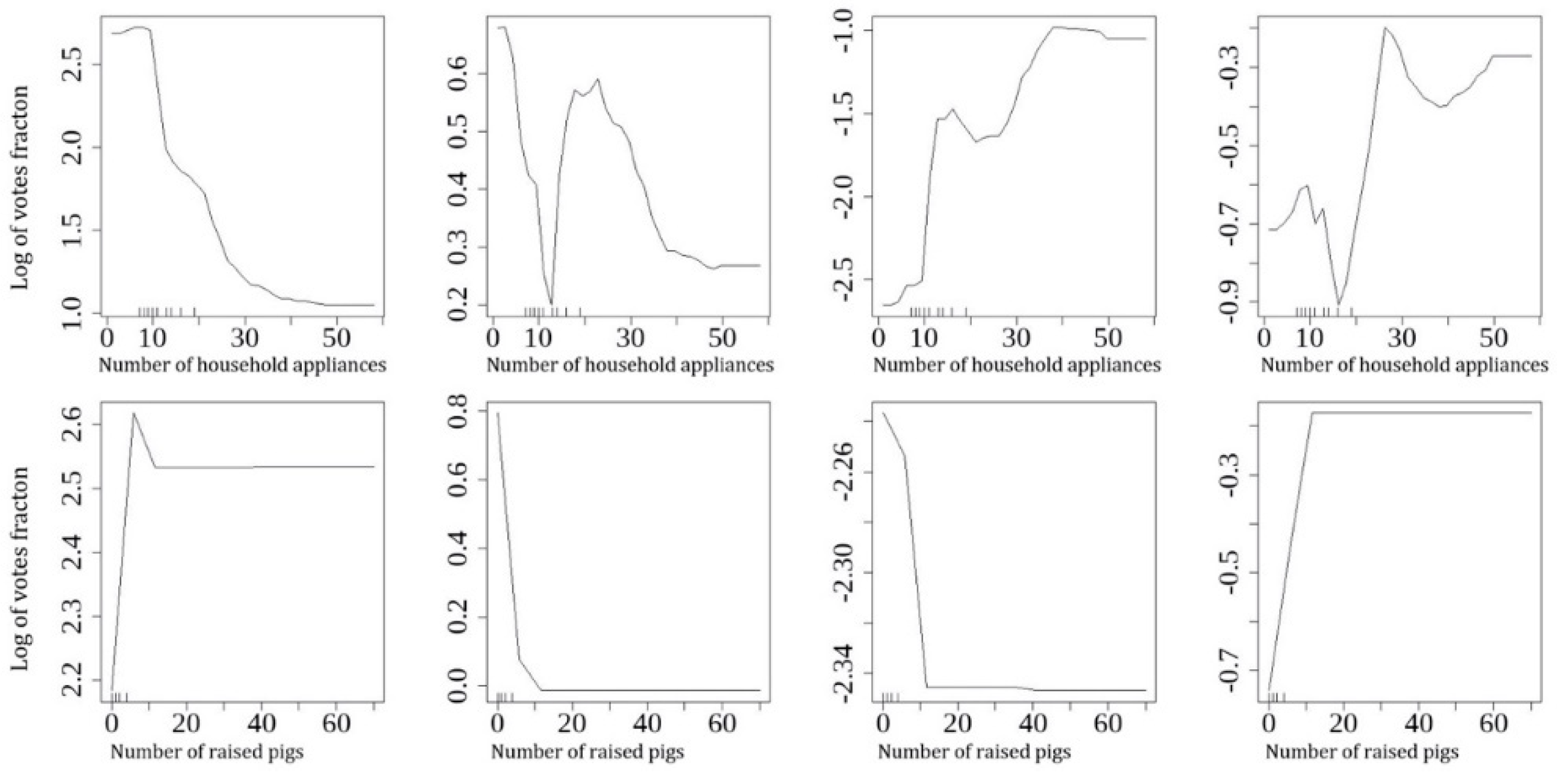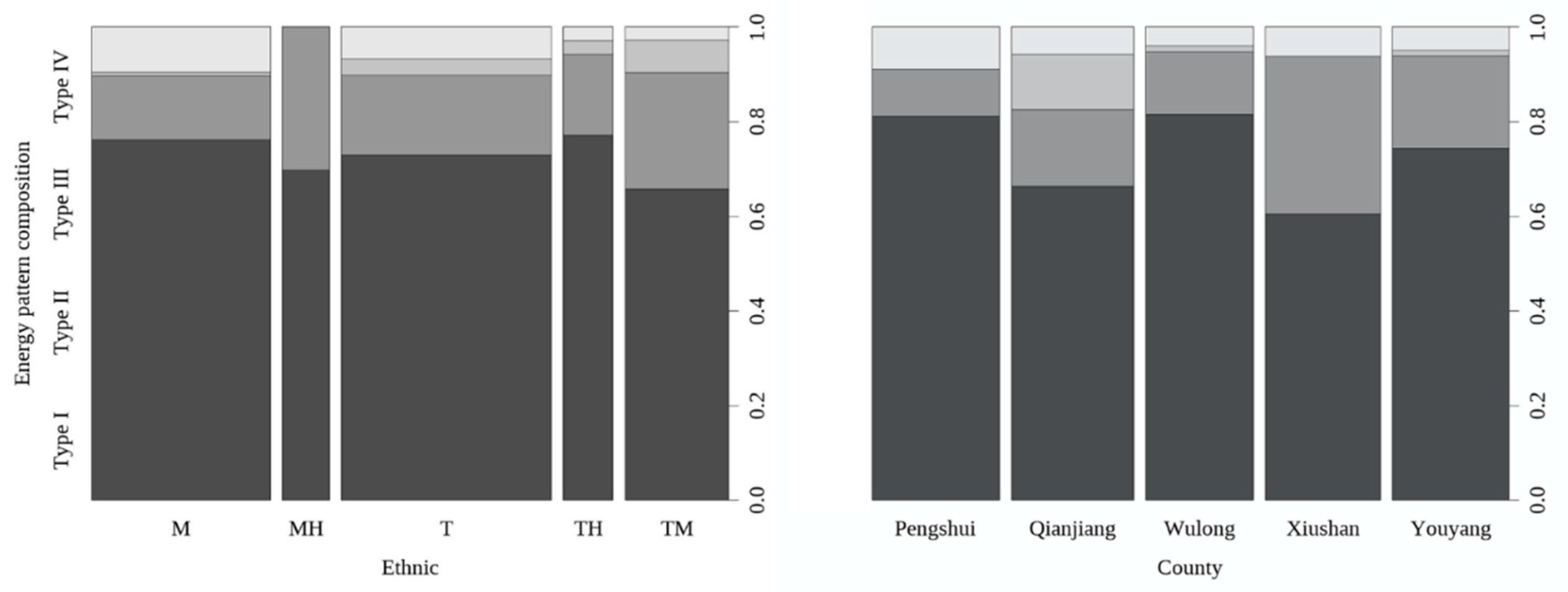Using Characteristic Energy to Study Rural Ethnic Minorities’ Household Energy Consumption and Its Impact Factors in Chongqing, China
Abstract
1. Introduction
2. Materials and Methods
2.1. Study Area
2.2. Data Acquisition
2.3. Data Analysis
2.3.1. Households Categorization
2.3.2. Impact Factors of Household Energy Use
2.3.3. Characteristic Energy Sources
3. Results
3.1. Four Types of Ethnic Household Energy Use Pattern and Their Characteristic Energy Source
3.2. Energy Pattern at Different Income Levels
3.3. Impact Factors and Household Characteristics of Household Energy Use Pattern
4. Discussion
4.1. Using Characteristic Energy to Study Energy Use Patterns of Different Families
4.2. Using Characteristic Energy to Study Impact Factors of Household Energy Consumption
4.3. Management Suggestions Based on Characteristic Energy
5. Conclusions
Supplementary Materials
Author Contributions
Funding
Acknowledgments
Conflicts of Interest
References
- Department of Energy Statistics of China. China Energy Statistical Yearbook 2014; China Statistics Press: Beijing, China, 2015.
- Pachauri, S.; Jiang, L. The household energy transition in India and China. Energy Policy 2008, 36, 4022–4035. [Google Scholar] [CrossRef]
- Wilhite, H.; Nakagami, H.; Masuda, T.; Yamaga, Y.; Haneda, H. A cross-cultural analysis of household energy use behaviour in Japan and Norway. Energy Policy 1996, 24, 795–803. [Google Scholar] [CrossRef]
- Baiyegunhi, L.J.S.; Hassan, M.B. Rural household fuel energy transition: Evidence from Giwa LGA Kaduna State, Nigeria. Energy Sustain. Dev. 2014, 20, 30–35. [Google Scholar] [CrossRef]
- Macht, C.; Axinn, W.G.; Ghimire, D. Household Energy Consumption: Community Context and the Fuelwood Transition; Population Studies Center Research Report; Population Studies Center: Ann Arbor, MI, USA, 2007; Volume 07-629. [Google Scholar]
- Hosier, R.H.; Dowd, J. Household fuel choice in Zimbabwe. Resour. Energy 1987, 9, 347–361. [Google Scholar] [CrossRef]
- Elias, R.J.; Victor, D.G. Energy Transitions in Developing Countries: A Review of Concepts and Literature; Program on Energy and Sustainable Development, Working Paper; Stanford University: Stanford, CA, USA, 2005. [Google Scholar]
- Paudel, U.; Khatri, U.; Pant, K.P. Understanding the determinants of household cooking fuel choice in Afghanistan: A multinomial logit estimation. Energy 2018, 156, 55–62. [Google Scholar] [CrossRef]
- Masera, O.R.; Saatkamp, B.D.; Kammen, D.M. From linear fuel switching to multiple cooking strategies: A critique and alternative to the Energy ladder model. World Dev. 2000, 28, 2083–2103. [Google Scholar] [CrossRef]
- van der Kroon, B.; Brouwer, R.; van Beukering, P.J.H. The energy ladder: Theoretical myth or empirical truth? Results from a meta-analysis. Renew. Sustain. Energy Rev. 2013, 20, 504–513. [Google Scholar] [CrossRef]
- Xiaohua, W.; Kunquan, L.; Hua, L.; Di, B.; Jingru, L. Research on China’s rural household energy consumption—Household investigation of typical counties in 8 economic zones. Renew. Sustain. Energy Rev. 2017, 68, 28–32. [Google Scholar] [CrossRef]
- Li, J.; Chen, C.; Liu, H. Transition from non-commercial to commercial energy in rural China: Insights from the accessibility and affordability. Energy Policy 2019, 127, 392–403. [Google Scholar] [CrossRef]
- Chen, Q.; Yang, H.; Liu, T.; Zhang, L. Household biomass energy choice and its policy implications on improving rural livelihoods in Sichuan, China. Energy Policy 2016, 93, 291–302. [Google Scholar] [CrossRef]
- Lee, J.W. Long-run dynamics of renewable energy consumption on carbon emissions and economic growth in the European union. Int. J. Sustain. Dev. World Ecol. 2019, 26, 69–78. [Google Scholar] [CrossRef]
- Xiong, W.Q.; Yong, G. Strategies and Suggestions to Utilize Biomass Energy in Rural Areas of Chongqing. Adv. Mater. Res. 2012, 488–489, 975–979. [Google Scholar] [CrossRef]
- Xiao, Y.; Xiao, Q. Identifying key areas of ecosystem services potential to improve ecological management in Chongqing City, southwest China. Environ. Monit. Assess. 2018, 190, 258. [Google Scholar] [CrossRef] [PubMed]
- Fan, J.; Liang, Y.; Tao, A.; Sheng, K.; Ma, H.-L.; Xu, Y.; Wang, C.-S.; Sun, W. Energy policies for sustainable livelihoods and sustainable development of poor areas in China. Energy Policy 2011, 39, 1200–1212. [Google Scholar] [CrossRef]
- Lai, C.S.; Tao, Y.; Xu, F.; Ng, W.W.Y.; Jia, Y.; Yuan, H.; Huang, C.; Lai, L.L.; Xu, Z.; Locatelli, G. A robust correlation analysis framework for imbalanced and dichotomous data with uncertainty. Inf. Sci. 2019, 470, 58–77. [Google Scholar] [CrossRef]
- Kohonen, T. Self-Organizing Maps, 3rd ed.; Springer: Berlin/Heidelberg, Germany; New York, NY, USA, 2001; p. 528. [Google Scholar]
- Cutler, D.R.; Edwards, T.C., Jr.; Beard, K.H.; Cutler, A.; Hess, K.T.; Gibson, J.; Lawler, J.J. Random forests for classification in ecology. Ecology 2007, 88, 2783–2792. [Google Scholar] [CrossRef]
- Dufrêne, M.; Legendre, P. Species assemblages and indicator species: The need for a flexible asymmetrical approach. Ecol. Monogr. 1997, 67, 345–366. [Google Scholar] [CrossRef]
- Moreno, C.E.; Calderón-Patrón, J.M.; Martín-Regalado, N.; Martínez-Falcón, A.P.; Ortega-Martínez, I.J.; Rios-Díaz, C.L.; Rosas, F. Measuring species diversity in the tropics: A review of methodological approaches and framework for future studies. Biotropica 2018, 50, 929–941. [Google Scholar] [CrossRef]
- R Core Team. R: A Language and Environment for Statistical Computing; R Foundation for Statistical Computing: Vienna, Austria, 2018. [Google Scholar]
- Paul, J.; Verleysen, M.; Dupont, P. Identification of statistically significant features from random forests. In Proceedings of the ECML workshop on Solving Complex Machine Learning Problems with Ensemble Methods, Prague, Czech Republic, 27 September 2013. [Google Scholar]
- Greenwell, B.M. pdp: An R Package for Constructing Partial Dependence Plots. R J. 2017, 9, 421. [Google Scholar] [CrossRef]
- Song, C.; Bilsborrow, R.; Jagger, P.; Zhang, Q.; Chen, X.; Huang, Q. Rural Household Energy Use and Its Determinants in China: How Important Are Influences of Payment for Ecosystem Services vs. Other Factors? Ecol. Econ. 2018, 145, 148–159. [Google Scholar] [CrossRef]
- Hiemstra-van der Horst, G.; Hovorka, A.J. Reassessing the “energy ladder”: Household energy use in Maun, Botswana. Energy Policy 2008, 36, 3333–3344. [Google Scholar] [CrossRef]
- Jian, Z. The recent trend of ethnic intermarriage in China: An analysis based on the census data. J. Chin. Sociol. 2017, 4, 11. [Google Scholar] [CrossRef]
- Pachauri, S.; Spreng, D. Energy use and energy access in relation to poverty. Econ. Political Wkly. 2004, 39, 271–278. [Google Scholar]
- Nie, H.; Kemp, R.; Xu, J.; Vasseur, V.; Fan, Y. Drivers of urban and rural residential energy consumption in China from the perspectives of climate and economic effects. J. Clean. Prod. 2018, 172, 2954–2963. [Google Scholar] [CrossRef]
- Sheng, C.; Cao, Y.; Xue, B. Residential Energy Sustainability in China and Germany: The Impact of National Energy Policy System. Sustainability 2018, 10, 4535. [Google Scholar] [CrossRef]
- Mills, B.; Schleich, J. Residential energy-efficient technology adoption, energy conservation, knowledge, and attitudes: An analysis of European countries. Energy Policy 2012, 49, 616–628. [Google Scholar] [CrossRef]
- Ma, X.; Wang, M.; Li, C. A Summary on Research of Household Energy Consumption: A Bibliometric Analysis. Sustainability 2020, 12, 316. [Google Scholar] [CrossRef]
- Kowsari, R.; Zerriffi, H. Three dimensional energy profile: A conceptual framework for assessing household energy use. Energy Policy 2011, 39, 7505–7517. [Google Scholar] [CrossRef]
- Lai, C.S.; McCulloch, M.D. Levelized cost of electricity for solar photovoltaic and electrical energy storage. Appl. Energy 2017, 190, 191–203. [Google Scholar] [CrossRef]
- Lai, T.C.; Tsang, K.F.; Liu, Y.C.; Lai, L.L. A Temperature Prediction Method of Valve-regulated Lead-acid Battery. In Proceedings of the 28th IEEE International Symposium on Industrial Electronics (ISIE 2019), Vancouver, BC, Canada, 12–14 June 2019; Institute of Electrical and Electronics Engineers Inc.: Piscataway Township, NJ, USA, 2019. [Google Scholar]





| Categories of Factors | Potential Impact Factors of Household Energy Consumption Pattern |
|---|---|
| Basic family information | ethnic, number of permanent residents (hNUM), household annual income (INCOME), education level of householder (EDU), percentage of members older than 65 years (A65) or less than 14 years old (A14), percentage of adult female members (aFEMALE) |
| Spatial position | distance to the county where they belong (DIST), altitude (ALTEs), village name |
| Household livelihood capital | number of household appliances (ElecApp), house area (hAREA), house structure (hSTR), farmland area (FARM), economic forest area (FOREST), ecological forest area (ECOLAND) |
| Production and lifestyle | number of pigs raised (PIG), diversity of livelihoods, which is the number of occupations that family members have (DIVERSITY), livelihood strategies (STRA) |
| Energy Structure | Household Number | Characteristic Energy | A | B | IV | Average Total Energy Kgce | Standard Deviation of Total Energy |
|---|---|---|---|---|---|---|---|
| Type I | 302 | Firewood | 0.656 | 1.000 | 0.810 | 4635 | 5781 |
| Type II | 76 | Electricity | 0.462 | 1.000 | 0.680 | 1887 | 1462 |
| Type III | 12 | Coal | 0.890 | 1.000 | 0.943 | 3622 | 4101 |
| Type IV | 25 | Gasoline | 0.671 | 1.000 | 0.819 | 8322 | 12,832 |
| Type II | Type III | Type IV | |
|---|---|---|---|
| Type I | PIG | ElecApp/PIG | ElecApp |
| Type II | - | ElecApp | ElecApp/PIG |
| Type III | - | - | PIG |
© 2020 by the authors. Licensee MDPI, Basel, Switzerland. This article is an open access article distributed under the terms and conditions of the Creative Commons Attribution (CC BY) license (http://creativecommons.org/licenses/by/4.0/).
Share and Cite
Mao, S.; Qiu, S.; Li, T.; Tang, M.; Deng, H.; Zheng, H. Using Characteristic Energy to Study Rural Ethnic Minorities’ Household Energy Consumption and Its Impact Factors in Chongqing, China. Sustainability 2020, 12, 6898. https://doi.org/10.3390/su12176898
Mao S, Qiu S, Li T, Tang M, Deng H, Zheng H. Using Characteristic Energy to Study Rural Ethnic Minorities’ Household Energy Consumption and Its Impact Factors in Chongqing, China. Sustainability. 2020; 12(17):6898. https://doi.org/10.3390/su12176898
Chicago/Turabian StyleMao, Shuxin, Sha Qiu, Tao Li, Mingfang Tang, Hongbing Deng, and Hua Zheng. 2020. "Using Characteristic Energy to Study Rural Ethnic Minorities’ Household Energy Consumption and Its Impact Factors in Chongqing, China" Sustainability 12, no. 17: 6898. https://doi.org/10.3390/su12176898
APA StyleMao, S., Qiu, S., Li, T., Tang, M., Deng, H., & Zheng, H. (2020). Using Characteristic Energy to Study Rural Ethnic Minorities’ Household Energy Consumption and Its Impact Factors in Chongqing, China. Sustainability, 12(17), 6898. https://doi.org/10.3390/su12176898








